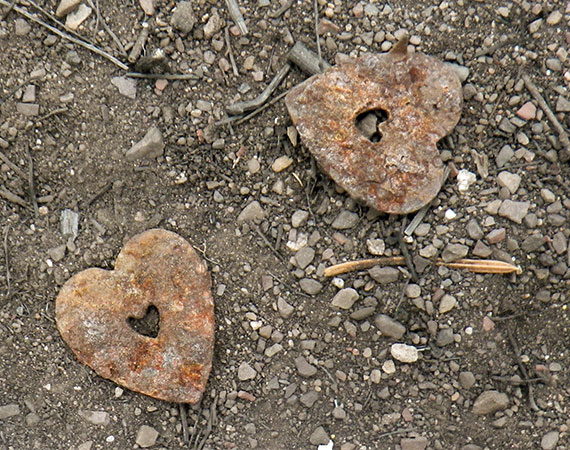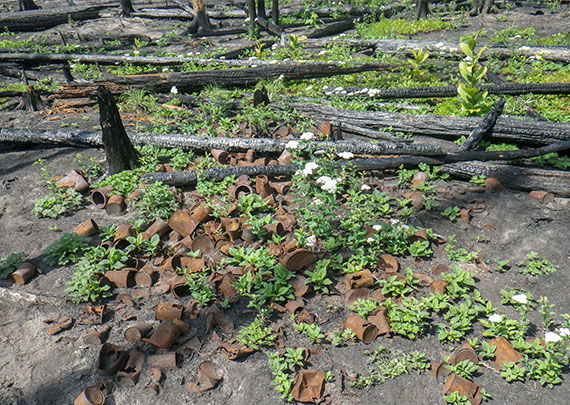
These tiny heart-shaped objects are tobacco tags
Red Rock historical
Waterton Lakes National Park
Archaeology is the study of the past through material remains left by people.
Archaeologists divide the past into time periods based on the changes we see in past archaeological artifacts and features.
These changes often indicate technological innovation. Other times they reflect the movement of a different population into a specific region. Changes in cultural remains can also be seen in the landscape. The idea of a cultural landscape conveys how we interact with the landscape, and in turn, how it shapes us.
The Blakiston Creek Valley is a significant component of the Waterton Lakes National Park cultural landscape, with evidence of occupation dating back roughly 10,000 years.
Together with changes in technology, we can observe the movement of a ‘new’ population into the region: European settlers.
In early May 2018, Parks Canada organized a volunteer event Clean Sweep for Wildlife along the Red Rock Parkway where the Kenow Wildfire had exposed significant amounts of litter. Two archaeologists accompanied volunteers and Park employees to assess what was found, looking for known and unknown occupations along the Parkway.
These finds illustrate how different stories were inscribed upon the landscape.
Tobacco tags

These tiny heart-shaped objects are tobacco tags. They were attached to plugs of tobacco manufactured by the W.C. MacDonald Tobacco Company in Montreal. These tags were in use from 1870-1922. They are a particularly interesting find, as we start to see these tags in the time period termed the Protohistoric. This time period marks the introduction of European trade goods into the archaeological record, but generally pre-dates the arrival of settlers.
Trade goods such as these may indicate direct trade with Europeans in the area, or indirect trade with Europeans via trade with other First Nations. However, the context of these tags was ambiguous - they could have also arrived with the first European prospectors to arrive in the Park.
Soda bottles

These Orange Crush bottles are from the Historical Period, a time period that in the West represents the colonization of the prairies up until about 1950. The year 1950 is used as the upper boundary because of the introduction of centralized mass production. Very little meaningful information can be gleaned from materials that post-date 1950.
The Orange Crush bottle on the left has a patent date of August 22, 1921. This bottle type was only manufactured for a few years.On the right is a later version, introduced in the 1940s and manufactured into the 1970s. These bottles may have belonged to workers in the area or to tourists using the park for leisure.
They represent a shift in the meaning of the landscape to the people that inhabited it. Many of the bottles we have found represent a time period when beer and soda were locally produced and bottled. Many people local to southern Alberta will recall the bottle in the image below.

Lethbridge brewery
On the right is a Sicks' 6 soda pop bottle dating to 1955-65. They were found overlooking a small waterfall in a scenic location in the park.
The Lethbridge Sicks' brewery was founded in 1901 and operated and until 1990. The brewery produced soft drinks from the early 1900s until 1965. The bottle on the left had no diagnostic features.
Midden: An archaeological garbage dump

The photo is of a garbage midden (old dump for domestic waste) that dates back to the 1930s. It is possible that it was left by workers making improvements to the Red Rock Parkway during one of many unemployment relief programs operating in the Great Depression era. Though these artifacts represent a small fraction of what we are finding in Waterton Lakes National Park, they illustrate how the cultural landscape takes on different meanings and tells us different stories about those who used it.
The Blakiston Creek valley tells us about hunting and food gathering, prospecting for oil and minerals like copper, how the Great Depression touched even National Parks, through to how people use the landscape for leisure and recreation. Each new find enriches our understanding of these different stories.
Related links
- Wildfire effects on bats in Waterton Lakes National Park
- Reducing human impact in the backcountry
- Salamander tunnel fencing restoration after wildfire
- Watching wildlife in the Waterton Valley
- Rising from the ashes
- Wildlife and wildfire
- Trail crew at work
- Archaeology in a burned landscape
- Clean sweep for wildlife
- Date modified :